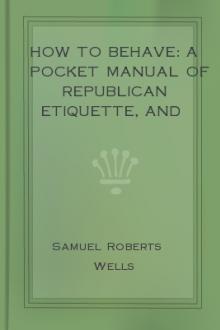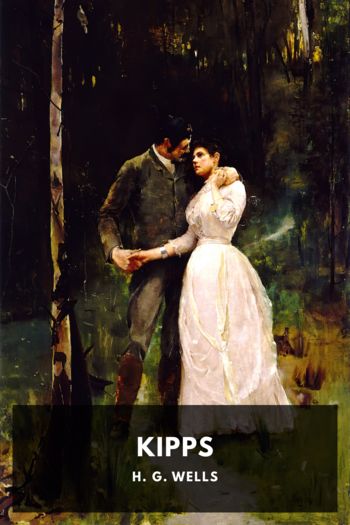How to Behave: A Pocket Manual of Republican Etiquette, and Guide to Correct Personal Habits, Samuel Roberts Wells [korean novels in english .TXT] 📗

- Author: Samuel Roberts Wells
- Performer: -
Book online «How to Behave: A Pocket Manual of Republican Etiquette, and Guide to Correct Personal Habits, Samuel Roberts Wells [korean novels in english .TXT] 📗». Author Samuel Roberts Wells
The fashionable fur hat, in its innumerable but always ugly forms, is, in the eye of taste, an absurd and unsightly covering for the head; and it is hardly less uncomfortable and unhealthful than ugly. The fine, soft, and more picturesque felt hats now, we are glad to say, coming more and more into vogue, are far more comfortable and healthful. A light, fine straw hat is the best for summer.
The bonnets of the ladies, in their fashionable forms, are only a little less ugly and unbecoming than the fur hats of the gentlemen. A broad-brimmed or gipsy hat is far more becoming to most women than the common bonnet. We hope to live to see both "stove-pipe hats" and "sugar-scoop bonnets" abolished; but, in the mean time let those wear them who must.
V.—MRS. MANNERS ON DRESS.Mrs. Manners, the highest authority we can possibly quote in such matters, has the following hints to girls, which we can not deny ourselves the pleasure of copying, though they may seem, in part, a repetition of remarks already made:
"Good taste is indispensable in dress, but that, united to neatness, is all that is necessary—that is the fabled cestus of Venus which gave beauty to its wearer. Good taste involves suitable fabrics—a neat and becoming 'fitting' to her figure—colors suited to her complexion, and a simple and unaffected manner of wearing one's clothes. A worsted dress in a warm day, or a white one in a cold day, or a light, thin one in a windy day, are all in bad taste. Very fine or very delicate dresses worn in the street, or very highly ornamented clothes worn to church or to shop in, are in bad taste. Very long dresses worn in muddy or dusty weather, even if long dresses are the fashion, are still in bad taste.
"Deep and bright-colored gloves are always in bad taste; very few persons are careful enough in selecting gloves. Light shoes and dark dresses, white stockings and dark dresses, dark stockings and light dresses, are not indicative of good taste. A girl with neatly and properly dressed feet, with neat, well-fitting gloves, smoothly arranged hair, and a clean, well-made dress, who walks well, and speaks well, and, above all, acts politely and kindly, is a lady, and no wealth is required here. Fine clothes and fine airs are abashed before such propriety and good taste. Thus the poorest may be so attired as to appear as lady-like as the wealthiest; nothing is more vulgar than the idea that money makes a lady, or that fine clothes can do it."
VI.—WEARING THE HAIR AND BEARD.The hair and beard, in one of their aspects, belong to the dress. In reference to the style of wearing them, consult the general principles of taste. A man to whom nature has given a handsome beard, deforms himself sadly by shaving—at least, that is our opinion; and on this point fashion and good taste agree. The full beard is now more common than the shaven face in all our large cities.
In the dressing of the hair there is room for the display of a great deal of taste and judgment. The style should vary with the different forms of face. Lardner's "Young Ladies' Manual" has the following hints to the gentler sex. Gentlemen can modify them to suit their case:
"After a few experiments, a lady may very easily decide what mode of dressing her hair, and what head-dress renders her face most attractive.
"Ringlets hanging about the forehead suit almost every one. On the other hand, the fashion of putting the hair smoothly, and drawing it back on either side, is becoming to few; it has a look of vanity instead of simplicity: the face must do every thing for it, which is asking too much, especially as hair, in its pure state, is the ornament intended for it by nature. Hair is to the human aspect what foliage is to the landscape.
"Light hair is generally most becoming when curled. For a round face, the curls should be made in short, half ringlets, reaching a little below the ears. For an oval face, long and thick ringlets are suitable; but if the face be thin and sharp, the ringlets should be light, and not too long, nor too many in number.
"When dark hair is curled, the ringlets should never fall in heavy masses upon the shoulders. Open braids are very beautiful when made of dark hair; they are also becoming to light-haired persons. A simple and graceful mode of arranging the hair is to fold the front locks behind the ears, permitting the ends to fall in a couple of ringlets on either side behind.
"Another beautiful mode of dressing the hair, and one very appropriate in damp weather, when it will keep in curl, is to loop up the ringlets with small hair-pins on either side of the face and behind the ears, and pass a light band of braided hair over them.
"Persons with very long, narrow heads may wear the hair knotted very low at the back of the neck. If the head be long, but not very narrow, the back hair may be drawn to one side, braided in a thick braid, and wound around the head. When the head is round, the hair should be formed in a braid in the middle of the back of the head. If the braid be made to resemble a basket, and a few curls permitted to fall from within it, the shape of the head is much improved."
VII.—ART VS. FASHION.Observe that we have been laying down some of the maxims deduced from the principles of art and taste, in their application to dress, and not promulgating the edicts of Fashion. If there is a lack of harmony on some points, between the two, it is not our fault. We have endeavored to give you some useful hints in reference to the beautiful and the fitting in costume, based on a higher law than the enactments of the fashion-makers. You must judge for yourself how far you can make the latter bend to the former. We have been talking of dress as an individual matter. In future chapters we shall have occasion to refer to it in its relation to the usages of society.
VIII.—SIGNS OF "THE GOOD TIME COMING."N. P. Willis, in the Home Journal, writing on the dress-reform agitation, thus closes his disquisition:
"We repeat, that we see signs which look to us as if the present excitement as to one fashion were turning into a universal inquiry as to the sense or propriety of any fashion at all. When the subject shall have been fully discussed, and public attention fully awakened, common sense will probably take the direction of the matter, and opinion will settle in some shape which, at least, may reject former excesses and absurdities. Some moderate similarity of dress is doubtless necessary, and there are proper times and places for long dresses and short dresses. These and other points the ladies are likely to come to new decisions about. While they consult health, cleanliness, and convenience, however, we venture to express a hope that they will get rid of the present slavish uniformity—that what is becoming to each may be worn without fear of unfashionableness, and that in this way we may see every woman dressed somewhat differently and to her own best advantage, and the proportion of beauty largely increased, as it would, thereby, most assuredly be."
FOOTNOTE:
[A] "Hints toward Physical Perfection; or, How to Acquire and Retain Beauty, Grace, and Strength, and Secure Long Life and Perpetual Youth."
III. SELF-CULTUREThere is no man who can so easily and so naturally become in all points a Gentleman Knight, without fear and without reproach, as a true American Republican.—James Parton.
I.—MORAL AND SOCIAL TRAINING.aving given due attention to your personal habits and dress, consider what special errors still remain to be corrected, or what deficiencies to be supplied, and carefully and perseveringly apply yourself to the required self-training.
If you are sensible of an inadequate development of any of those faculties or feelings on which good manners are based, set yourself at once about the work of cultivation, remembering that the legitimate exercise of any organ or function necessarily tends to its development. Look first to conscientiousness. It is hardly possible for you to acquire genuine good manners without an acute sense of equity. Accustom yourself to a sacred regard for the rights of others, even in the minutest matters, and in the most familiar intercourse of the family or social circle. In a similar manner cultivate Benevolence, Veneration, Adhesiveness, Agreeableness, Ideality, and the moral, social, and esthetic faculties in general. Go out of your way, if necessary, to perform acts of kindness and friendship; never omit the "thank you" which is due for the slightest possible favor, whether rendered by the highest or the lowest; be always bland and genial; respect times, places, observances, and especially persons; and put yourself in the way of all possible elevating and refining influences. Manners have their origin in the mind and the heart. Manners do not make the man, as is sometimes asserted; but the man makes the manners. It is true, however, that the manners react upon mind and heart, continually developing and improving the qualities out of which they spring.
You are placed in a particular community, or you are invited or wish to gain admittance into a certain circle. Different communities and circles require, to some extent, different qualifications. Ascertain what you lack and acquire it as speedily as possible; but remember that good sense and good nature are out of place in no company.
II.—LANGUAGE.Conversation plays an important part in the intercourse of society. It is a great and valuable accomplishment to be able to talk well. Cultivate language and the voice. Learn to express yourself with correctness, ease, and elegance. This subject is worthy of all the time and study you can give to it. "How to Talk: a Pocket Manual of Conversation and Debate," which forms one of this series of "Hand-Books for Home Improvement," will give you all necessary aid in this department.
III.—POSITION AND MOVEMENT.Study also the graces of manner, motion, and position. Grace is natural, no doubt, but most of us have nearly lost sight of nature. It is often with the greatest difficulty that we find our way back to her paths. It seems a simple and easy thing to walk, and a still easier and simpler thing to stand or sit, but not one in twenty perform either of these acts with ease and grace. There are a hundred little things connected with attitude, movement, the carriage of the arms, the position of the feet and the like, which, though seemingly unimportant are really essential to elegance and ease. Never despise these little things, or be ashamed to acquire the smallest grace by study and practice.
You desire to be a person of "good standing" in society. How do you stand? We refer now to the artistic or esthetic point of view. If you are awkward, you are more likely to manifest your awkwardness in standing than in walking. Do you know where to put your feet and what to do with your hands? In the absence of any better rule or example, try to forget your limbs, and let them take care of themselves. But observe the attitudes which sculptors give to their statues; and study





Comments (0)